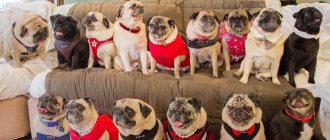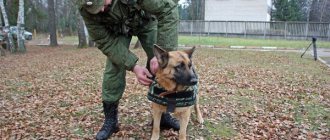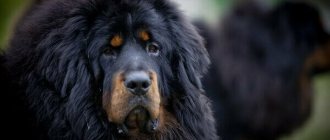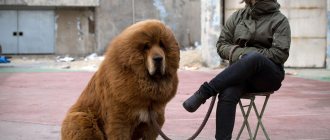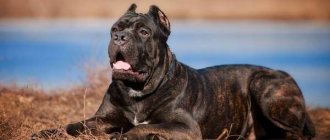French bulldogs are a prime example of why you shouldn't judge a dog by its appearance.
A little formidable, due to the folds and peculiar furrows on the muzzle, the appearance of the “Frenchies” does not fit in with their kindness, cheerful disposition and lack of aggression.
The multi-faceted nature of these dogs makes them wonderful life partners.
Especially for those who decide to have such a four-legged friend, however, you need to be prepared for some inconveniences.
Let's look at everything in detail.
Breed traits
Breed traits (on a 5-point scale)
| French Bulldog | |||
| Activity | in the house | 2.3 | |
| on the street | 2.4 | ||
| Obedience | training | 2.6 | |
| strangers | 3.1 | ||
| Domination | in family | 1.4 | |
| over dogs | 3.2 | ||
| Defending your territory | from people | 1.2 | |
| from dogs | 3 | ||
| Sociability | in family | 5 | |
| with strangers | 4.8 | ||
| with dogs | 3.8 | ||
| Concentration | in family | 1.1 | |
| in front of strangers | 1.2 | ||
| with dogs | 1.7 | ||
| Aggressiveness | in family | 1.1 | |
| to strangers | 1.2 | ||
| to the dogs | 2.7 | ||
| to cats | 2.6 | ||
| Family behavior | calmness | 3.2 | |
| demand for affection | 4.4 | ||
| excitability | 3.3 | ||
| playfulness | 4.2 | ||
| excessive barking | 1.8 | ||
| behavioral breakdowns | 1.7 | ||
| Tolerance for children | up to 4 years | 4.2 | |
| over 4 years old | 4.3 | ||
| Institutional use | watchman | 3.3 | |
| bodyguard | 1.3 | ||
This breed is often compared to the following dog breeds: English Bulldog, Beagle, Pembroke Welsh Corgi, Jack Russell Terrier, Pug.
French bulldogs: general characteristics of the breed
French bulldog named Hammer
Despite their origin and ferocious appearance, these animals are very good-natured and sociable. This is a decorative dog, suitable for keeping in a city apartment. Does not require special care, gets along easily with all family members and other animals. The popularity of French bulldogs is explained by the following characteristics:
- they do not need much physical activity, walking is enough;
- rarely bark, non-aggressive;
- very attached to all family members;
- unpretentious, adapt to any conditions;
- small stature suitable for keeping in a small apartment;
- friendly and cautious by nature;
- can be an ideal companion for a lonely pensioner;
- do not require special care;
- trainable, very smart;
- there is a protective instinct;
- life expectancy 10-12 years.
Relaxing in the grass
But the breed has its drawbacks; such pets are not suitable for everyone. They are very sociable and do not tolerate loneliness well, which can cause them to become aggressive. Therefore, it is better not to get such a breed for people who are at work all day. The French Bulldog is also not suitable for a person who loves perfect cleanliness. Many disadvantages include the fact that they shed, can drool, and often suffer from flatulence. The puppy must be trained with patience and persistence. After all, these dogs are smart, but very stubborn and independent.
Owner reviews
Nikolai, 34 years old: “The bulldog appeared with us quite recently, but has already become everyone’s favorite. Children adore him, and he willingly plays with them. A very loyal and understanding dog."
Oksana, 27 years old: “Our Frenchman loves to eat, sleep and chew on toys. The breed is prone to obesity, so you need to monitor its diet and not give too much food, otherwise health problems may arise.”
Elena, 42 years old: “My daughter gave me a bulldog, and he immediately won me over! He behaves very well-mannered: he doesn’t chew shoes, he doesn’t bark for no reason. The only negative is poor health.”
To read: Review of varieties of the Terrier breed: description of medium and small types of dogs
History of the breed
For French bulldogs, the history of the breed began in the 19th century in England. The goal of the breeders was to create a companion dog, guard dog and rat hunter for keeping in urban environments. They crossed English bulldogs with pugs, terriers and other decorative pets. Only the smallest representatives of the breeds were used for breeding. Dogs appeared that were bred by artisans to hunt rats.
At the end of the 19th century, the French bulldog breed came to France. Her unusual appearance, mischievous disposition and good-natured character are the reason for her popularity. She became fashionable in high society. Thanks to this, the French bulldog has spread throughout the world. At the beginning of the 20th century, they were recognized as a separate breed and classified as decorative dogs. They became especially popular in America.
Basking in the sun
In Russia, the French bulldog breed was first popular among the nobility. Chaliapin, the royal family, and other famous people had such a pet. But the history of its breeding in our country was not easy. Since the 1920s, this breed has almost disappeared. After all, she was considered elite, pets were expensive. After the war, there was only one French bulldog left in the whole country in Moscow. They began to breed them again only in the 60s.
Description of appearance
The French Bulldog is a smaller version of the English Bulldog, but has some unique features in its appearance. The “Frenchman” became as we know him now in the second half of the 20th century. The main features of appearance are erect ears, shaped like the ears of a bat, a naturally docked tail, a snub nose and large eyes.
French bulldog puppy
After looking at photos of French bulldog puppies, many immediately fall in love with this breed. The expressive eyes are a little sad, which gives the muzzle an offended expression. And his big protruding ears make him funny and cute.
According to the international classification, the breed belongs to the decorative dogs, to the group of small Molossians. The breed standard was adopted in the 20th century, but changes were made to the description of the French bulldog several times.
Dimensions
French bulldogs are medium in size. The height at the withers is from 25 to 35 cm. But because of their strong bones and powerful build, the “Frenchies” weigh a lot. Bitches may be smaller in size. Their weight is from 8 to 12 kg, for boys - up to 10-15 kg.
Torso
Dinner
The first impression of them is that of a powerful, lively and strong animal. This is immediately visible from any photo of representatives of the breed. A wide, cylindrical chest, a short neck, slightly widening towards the shoulders, and powerful, prominent muscles make the Frenchman a small Molosser. The height at the withers is slightly less than the height at the rump. The ribs are rounded, the chest is low and wide, and the stomach is tucked.
The back is muscular, short, the topline slopes slightly from the withers to the loin. The tail is short and set low. By nature it is broken and twisted, sometimes downward.
Limbs
French bulldog puppy
The “French” have short, powerful limbs with prominent muscles. The bones are short, all joints are well defined. The elbows are pressed to the body, and the paws themselves are small, the toes are gathered into a ball. When moving, the limbs are parallel.
Because of this structure of the limbs, the “French” have several features:
- from the side the animal appears stooped, since the front legs are slightly shorter than the hind legs;
- likes to lie on his stomach with his hind legs extended;
- can't swim at all.
Head
The massive head has an almost square outline. It is wide, with a convex forehead and a weakly defined occipital protuberance. There is a deep furrow between the clearly visible brow ridges. The nasal bones are shortened, so the stop is sharp.
The entire muzzle of a French bulldog is covered with folds: there are several of them on the nose, and they go to the upper lip, which also hangs down in a wide fold. The lower jaw protrudes slightly forward, but the teeth should not be visible when the mouth is closed. These animals often exhibit overbite, and some puppies are born with a cleft soft palate.
Muzzle
French bulldog puppy
The muzzle is short, slightly upturned. The nose is wide, the nostrils are wide open and directed upward, and the bridge of the nose is short and wide. That's why the nose appears snub-nosed. Because of this feature, many animals breathe heavily, with frequent grunting, and may snore in their sleep.
The ears of dogs of this breed are set wide and high. They are large and shaped like bat ears. Rounded at the ends and turned forward. The French Bulldog's eyes are large, round and protruding. Set wide and low. They are very expressive, their eyes are intelligent and friendly, this can be seen even in the photo.
Wool
The coat is short, thick, fine and smooth. It lies close to the body and has no undercoat. Therefore, the pet does not tolerate frost well. But thanks to these characteristics of the coat, the French bulldog does not cause allergies.
The colors are very diverse: brindle, fawn, spotted, black and white. Unnatural, therefore not standard, blue, chocolate, tricolor. The most common are white French bulldogs, sometimes with spots. Brindle, white with black spots, are also popular. A dark mask on the face is welcome for any color.
Flaws
French bulldog puppy
When breeding dogs, puppies are sometimes born that do not meet the breed standard. Flaws in appearance do not allow them to participate in shows or obtain a good pedigree. Because of them, such animals cannot be used for breeding. Although this does not prevent them from becoming favorite pets and companions of those who do not care whether the dog is purebred or not.
The following qualities are most often included in the description of the shortcomings of representatives of the breed:
- a wide black stripe along the back or many dark spots;
- white areas on paws, light claws;
- long or too short muzzle;
- when the mouth is closed, the tongue or teeth are visible;
- straight bite;
- gray, black or blue eyes;
- smooth topline;
- nose and lips are not black;
- ears are not standing;
- height above 35 cm;
- the coat is harsh or long;
- color blue, pure black or white without spots.
- Boys have almost no sexual characteristics.
Colors from photos
Although you can find French Bulldogs in a variety of colors, the standard allows only three varieties: brindle, fawn and spotted. All colors with photos and their subspecies are described below.
Brindle (Brindle)
It is formed by alternating stripes. Color varies from wheaten with dark areas to almost black with isolated red hairs.
Fawn (Fauve)
Varies from light biscuit to deep red. There are two types:
- Single color (fawn). The color of the coat is any range of fawn: from gray-milky to bright red.
- With brindle or streaks (brindle). On the main background there are dark transverse stripes. Their number and thickness vary: from single thin to a large number of darkened areas. Similar to brindle, but genetically they are different colors.
Additional Information! With brindle and fawn colors, small light spots on the chest and head, as well as a mask on the face, are acceptable.
Spotted (Caille)
Characterized by the arrangement of colored spots on a white background. It is formed with increased piebaldity: when light areas displace dark ones. There are two types of suit:
- White spots alternate with brindle: white & brindle.
- White areas alternate with fawn: white & fawn.
Sometimes in spotted French bulldogs the white color is so dominant that it displaces all colored areas. Visually, it seems that such dogs are snow-white. In reality, this is not the case: only the fur lacks pigment, and there are noticeable dark spots on the skin.
Character and education
The French Bulldog is a balanced, active, intelligent and kind dog. She needs communication, attention and affection. Animals are very sociable and loving. They treat all family members kindly. Very playful, but will never pester. The peculiarity of the French bulldog's character is that it senses the owner's mood; if he is not ready to play, he will move away. But when he is upset about something, they will try to cheer him up and console him.
They can be aggressive or selfish towards other pets. They are individualists and very jealous. On the street they can get into fights with large dogs. They do not get along well with cats.
White French Bulldog
They are usually friendly with children. But it is recommended to ensure that the child does not hurt the pet while playing, otherwise he will snap. You need to teach your child to treat the animal kindly, not to take away toys, and not to pester him when he eats. Relationships with a new family member can be difficult. When a newborn appears in the house where such a pet lives, the dog may be jealous.
These animals become very attached to their owner. They are devoted to him until the end of their lives. When he leaves, they miss him greatly and greet him with joy. They do not tolerate loneliness, they experience it very painfully, they can become sad or get sick. Sociable and kind “French” people are not only with their family, but even with guests or passers-by on the street. After all, they love when people pay attention to them and play with them.
Sometimes these good-natured animals can be selfish and vindictive. They are smart and do not tolerate rude treatment. If you constantly yell at or punish your pet, it can become angry and aggressive. But with a calm, respectful attitude, the French bulldog will become a true friend.
French Bulldog
Alexey, 43g
We gave a French Bulldog puppy to our daughter several years ago, she was 11 at the time. She asked for a white one, and that’s what she got! The daughter takes care of the bulldog on her own: trains, breeds, feeds, cares for. I help trim the nails, making sure that dirt does not accumulate in the folds.
I don't wash it often, just my paws every day. The dog gets along well with our cat, they even sleep next to each other. We feed him dry food, there are no problems with digestion. In winter we take her out for walks in overalls; my daughter bought it herself, as well as a beautiful leather harness. We were pleased with the choice of breed; the dog is good-natured and does not require complex care.
Minuses
Pets also have disadvantages, but problems can be avoided with proper upbringing. What negative characteristics are typical of the “French”:
- sometimes they are very active, playful, and can turn the whole house over;
- they remember the insult for a long time and can take revenge;
- due to a rude attitude they become aggressive and can bite;
- cannot stand loneliness;
- They can be stubborn and lazy.
Training
These are smart, quick-witted and calm animals with good reactions. They are easy to train and participate in agility and other canine sports. The peculiarity of dogs from the French bulldog breed is that they have a sense of humor. Their mischievous expression can be seen even in the photo.
We need to chew this stick...
You need to be patient when training and raising a French Bulldog. The “French” understand commands, but are in no hurry to carry them out. This is a companion dog and can change its behavior according to the situation. She will obey when she understands why it is necessary.
When training, you should ensure that the pet always follows the command. But this must be done without rudeness or punishment. If you don’t do this at least once, the pet will completely stop obeying. It is important to show the animal who is in charge as early as possible.
After the puppy appears in the house, it must be accustomed to a place, a bowl, and a toilet. These dogs are able to walk at home on a diaper. But even in this case, you still need to walk with your pet. He should know at least the basic commands: “place”, “fu”, “come to me”, “sit”. But the “French” quickly understand many words: “walk”, “bring”, “ball” and others.
Tips for choosing a puppy
Choose a puppy from reputable kennels from reputable parents. Pedigree raises the price of a dog, but guarantees a healthy, mentally stable dog who will grow up to be a French bulldog and not a little mongrel. It’s good if the breeder is happy to share photos and videos of puppies and give advice on care. It is recommended to separate French bulldog puppies from their mother no earlier than two months.
Included with the puppy is a puppy card, a veterinary passport, a brand and a contract for the purchase and sale of the dog, possibly a co-ownership agreement.
Keeping French Bulldogs
The life expectancy of “Frenchies” is 10-12 years, but with proper care they can live longer. To do this, the owner must understand their characteristics and needs. The most important thing is not to leave the animal alone for a long time. You can even take a bulldog with you on a trip; they tolerate transport well. The only warning is that these dogs, due to their physique, quickly overheat. In a hot room they may develop heatstroke.
French Bulldog
You need to keep an eye on your pet while walking. “The French” do not shy away from people, they are very voracious, they pick up from the ground and can take food from a stranger. It is impossible to say for sure how long to walk this dog. Dog handlers recommend at least an hour, but some animals are couch potatoes and some are more active. Therefore, the duration of the walk is determined individually.
Care
It is not difficult to care for such pets. Even a child can be trusted with this. With a good attitude, the dog will become a devoted friend. “The French” are unpretentious and feel great in a small city apartment. They do not require long walks or trips into nature. They do not tolerate cold and heat well, so they live comfortably only in the house.
French Bulldog - appearance
Caring for a French Bulldog includes the usual procedures.
- You need to keep your paws clean, wash them or wipe them with napkins after a walk. Bath completely when dirty, only use special shampoos. Bathing is usually recommended once every 1-2 months.
- The wool does not need to be cut or combed. It is recommended to brush it with a soft brush 2-3 times a week. During shedding, this should be done more often, and the fallen fur should be collected with a damp sponge.
- Once a day you need to examine and wipe your pet's eyes. Due to the fact that they are convex, injuries occur and inflammation can develop. If necessary, the eyes and ears are washed with a cotton pad or special solutions.
- Wipe the folds on the face with a soft cloth every day. Make sure that diaper rash does not appear.
- Teeth are a weak point in dogs of this breed. They wear down quickly and tartar may appear. It is recommended to give your pet treats and chewing bones, and to brush your teeth with special products once a week.
- If an animal walks for at least an hour a day, its claws will wear down naturally. Otherwise, you need to use a nail clipper.
Nutrition
This breed has a high risk of obesity. It is advisable to consult a veterinarian about how much food to give your animal. Two meals a day are usually recommended. For an adult dog without fat deposits, the amount of food should be 3-4% of body weight.
With natural feeding, half of this volume should consist of animal proteins. Usually this is meat, but offal can also be used. Once a week they give fish and egg yolk. The second half is fermented milk products. They are given as a separate feeding. An adult dog should not be given milk. Be sure to include vegetables, fruits, cereals, bran, and vegetable oil in your diet every day. Depending on age and health, the amount of food may be reduced.
French bulldog ears
You can feed your bulldog dry food. It is recommended to choose super-premium or holistic varieties. This food does not cause allergies and contains all the necessary nutrients. It should be designed for medium breed dogs. Veterinarians recommend the following brands of dry food for feeding French bulldogs:
- Brit Care;
- Acana;
- Orijen;
- Arden Grange;
It is easier to feed your pet dry food: the quantity is indicated on the package. It is usually calculated by the weight of the animal - 12-16 g/kg. You need to make sure your dog always has clean water.
Diseases
This breed is artificially bred and the animals are susceptible to many diseases. They are transmitted genetically, so when choosing a puppy you need to be interested in the health of the parents. Most often, the “French” suffer from the following diseases:
- brachycephalic syndrome, which causes pets to grunt, snore and pant;
- clefting or lengthening of the soft palate;
- hip dysplasia causes lameness;
- congenital anomaly of the knee joints;
- allergic reactions;
- pathologies of intervertebral discs develop mainly with age;
- blood clotting disorder;
- excess weight.
Puppies
Only purebred animals are allowed for breeding. They are ready for the appearance of offspring late: boys only by 2 years, girls a little earlier. Artificial insemination is usually used. Complications often occur during childbirth, so a caesarean section is performed.
French bulldog puppy fighting
Puppies are sold 2-2.5 months after birth. By this time, all vaccinations have already been completed and breastfeeding has been stopped. When purchasing, you need to pay attention to ensure that he is healthy, cheerful and playful. It is recommended to study photographs and reviews of breeders. You need to feed a puppy up to 3 months 5 times a day, at 4-7 months - 4 times, then up to a year - 3 times.
Marina
The French Bulldog is a great friend, very loyal and kind. Our Karinka, for example, loves when guests come, there is so much joy at once! If they don’t pay attention to her, she’s sad . Among the disadvantages: in the summer, when it’s hot, inflammation occurs in the folds, which needs to be treated. Our girl also snores, but we don’t let her into the bedroom, so these are minor things. Once we mated, the birth was not the easiest, we had to call a veterinarian. But everything worked out. The puppies were given to friends, they were very cute))) It saddens me that the dog’s life is short, and we are already 7 years old.
FAQ
Inexperienced dog breeders and those who just got a puppy often don’t know what to do in simple situations. Most problems can be solved without a doctor.
Is it possible to give bones to a French bulldog?
It is not recommended to give regular bones. Representatives of this breed wear down their teeth quickly. Bone fragments can injure your intestines or cause constipation.
How long do French bulldogs live?
The lifespan of a pet depends on the conditions of keeping, care, and nutrition. If he does not have genetic diseases, and is surrounded by love and care at home, he can live longer than the average 12 years.
Do French Bulldogs need to have their tail docked?
These dogs have a short tail and are not docked from birth.
Why glue puppies' ears?
With proper nutrition, the puppy's ears should stand up by 3-4 months. If this does not happen within six months, they are glued under the guidance of a veterinarian.
Why does my pet snore and grunt?
This is due to the peculiarities of the anatomy of the “French”. Due to the unusual structure of the nose and jaws, a dog can make different sounds when breathing.
Is it possible to keep a bulldog in an enclosure?
The French Bulldog can only be kept indoors. If he lives on the street or in an enclosure, he may die from cold and loneliness.
White French bulldog
The French Bulldog is an intelligent, quick-witted and very sociable dog. She is easy to train, persistent and stubborn. The character is balanced and calm, but if you anger her, she becomes dangerous: this dog is very strong, with a good reaction and a strong grip of her jaws.




